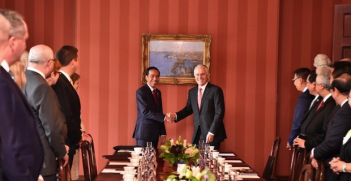The War on Islamic State After Paris: a Strategy Remaining and Expanding

To borrow from Islamic State’s slogan, the strategy of Western powers and their allies to defeat Islamic State looks like it will be remaining and expanding. This may not be wise.
After Islamic State (IS) claimed responsibility for terrorist attacks in Paris, Beirut and over the Sinai, the war on IS is set to intensify in the coming weeks. Any hope that Paris would signal a strategic turning point in this war – an opportunity to leverage global resolve and an increased commitment of resources to a revised strategy – was dashed when President Obama declared that ‘we have the right strategy and we are going to see it through’. Results have been mixed over the last year. While IS has lost chunks of territory across Syria and Iraq, Raqqa and Mosul remain its strongholds, formally aligned wilayats (provinces) have emerged in the Middle East, Africa and Asia, foreign fighters continue to stream to its territories whilst IS-inspired terrorist plots have become a major security concern for many Western nations. A key factor in many of these trends is the misunderstandings that underpin current strategies.
For instance, the strategy of containment that is central to combating IS was designed to halt IS’s territorial gains while increasing politico-military and economic pressures on the so-called caliphate to weaken its defensive capabilities and inspire rebellion within its territories. This approach was broadly founded on assumptions that IS is: primarily territorially focussed; largely reliant on coercion to control local populations; and fundamentally a terrorist organisation (if one masquerading as a state). Unfortunately these assumptions are accurate of only parts of IS – painting only a partial picture of the phenomenon.
IS is fundamentally an insurgency. Its own literature broadly echoes the core principles of many modern insurgency thinkers by calling for a phased politico-military strategy consisting of the hijrah (migration), jama’ah (organisation), destabilise the taghut (idolaters), tamkin (consolidation) and finally khilafah stages. Like other modern insurgencies, IS appears state-like in its strongholds (e.g. Raqqa), more like a guerrilla force outside these areas (e.g. across Anbar province) while, on the fringes of its reach, like a terrorist network (e.g. Europe). As analysts like Craig Whiteside have exhaustively explored, IS is willing to apply a mix of conventional (e.g. infantry manoeuvring) and unconventional (e.g. suicide bombings) combat operations to achieve broader political and governance objectives. Moreover, as analysed in a recent Australian Journal of International Affairs article, IS’s strategic communications campaign fuses rational and identity choice appeals as a means to lure supporters to its politico-military apparatus and ideological cause while coaxing contested populations away from its enemies.
However a modern insurgency requires time (and ideally space) to implement the phases of its campaign strategy and transform locals from tacit to active supporters. Based on a partial picture of the IS phenomenon, the strategy of containment may have inadvertently afforded IS time, particularly in its strongholds, to implement the phases of its campaign plan, build stronger and more resilient ties with local populations and leverage apparent successes against extraordinary odds to give apparent veracity to its propaganda claims. So, while IS may have lost a further 10 percent of its territory in the first six months of 2015 alone, its overall strategic position may have strengthened.
The same partial picture of IS-informed assessments suggested IS was not inclined to engage in Al Qaeda (AQ)-like transnational terrorism. Such perspectives ignored differences between what AQ and IS believe to be the legitimate methodology (manhaj) for achieving their objectives. Thus, IS’s engagement in transnational terrorism operations was merely a matter of timing; its priorities since 2012, both ideologically and strategically, have been to focus on implementing the phases of its insurgency campaign in the “fertile crescent”. Furthermore, such assessments overlooked IS’s history of transnational terrorism in its enemies’ homelands. Through IS’s strategic lens, transnational mass-casualty terrorism is designed to stretch its enemies’ front lines and coerce enemy populations into pressuring their governments into ceasing anti-IS efforts.
Self-soothing assumptions and hubristic short-sightedness continue to dominate strategic-policy discourse on combating IS. Within days of the Paris attacks, calls to soften rules of engagement as a demonstration of retributive strength ignore the likely “blow back” effect that would see populations already devastated by war pushed deeper into IS’s arms. Meanwhile, many continue to argue that the West must work with Syria’s Assad regime to first destroy IS and then work towards a political solution. Such a strategy risks turning swathes of Syrian opposition forces against the west for siding with a dictator that it has previously accused of crimes against humanity. A bad day in Paris is an average day in Syria and Western leaders would benefit from keeping this reality in mind. What is required now is a sober and calculating debate of anti-IS strategic-policy options that is based on both a comprehensive empirically-based understanding of IS and careful consideration of the second and third order effects of any strategy.
Dr Haroro J. Ingram is a Research Fellow at the Coral Bell School of Asia Pacific Affairs at the Australian National University. This article can be republished with attribution under a Creative Commons Licence.





